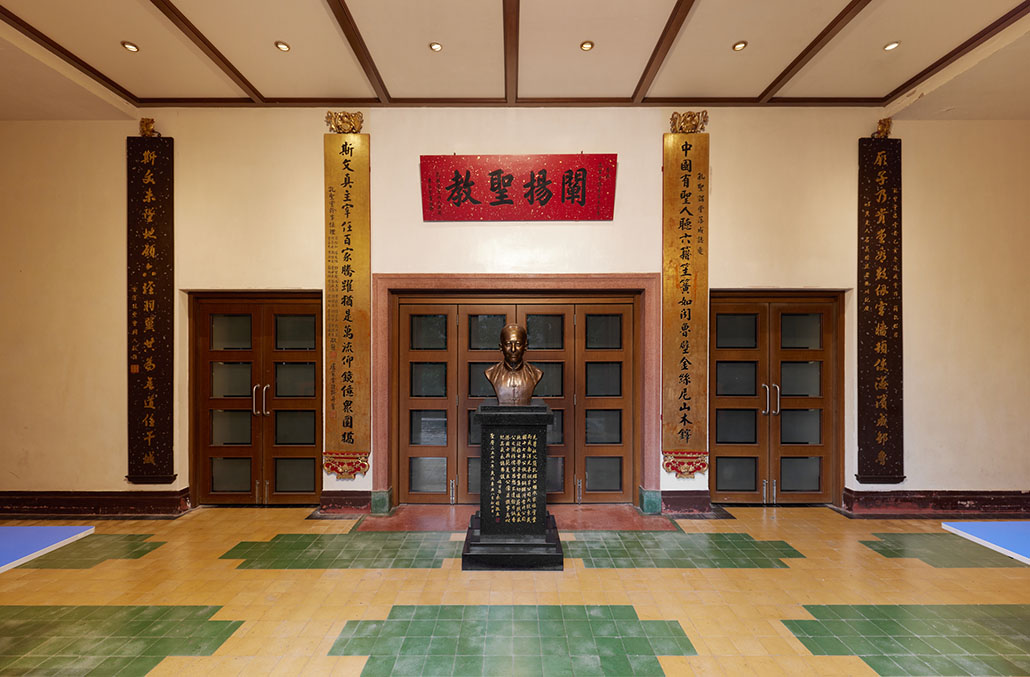Confucius Hall is located at 77 Caroline Hill Road, Causeway Bay, Hong Kong. Completed in 1935, the hall is the oldest Confucian teaching establishment in existence in Hong Kong today. In 1905, the Qing court abolished the Imperial Civil Service Examinations. Amidst the strong waves of Western influence on religion and academia in Hong Kong, many Chinese merchants, including Kan Hung-chiu, Tsang Foo, Shouson Chow, Sir Robert Kotewall, Tso Seen-wan and Chau Tsun-nin, along with renowned scholars Wen Su, Zhu Ru-zhen and so forth, hoped to unite the society through traditional ethics. They co-founded Confucius Hall as a venue for renowned scholars to give lectures and enlighten people through Chinese classic literature and ethics. Notably, Kan Hung-chiu donated land and fund for the construction of Confucius Hall.
Prior to the opening of Hong Kong City Hall in 1962, Confucius Hall was the main community hall in Hong Kong. It was open to the public for activities and lectures. A wide array of activities was held in Confucius Hall, including the celebration of Lu Hsun’s sixtieth birthday, the memorial service for Hsu Ti-shan, and commemorative activities for the May Fourth Movement. They underscored cultural inclusion in Hong Kong. Renowned scholars, such as Guo Mo-ruo, Mao Dun, Chi’en Mu, Tang Chun-i, Jao Tsung-i, Chan Cham-chuen, Du Wei-ming and Sin Chow-yiu, gave lectures at Confucius Hall.
During the Japanese Invasion, Confucius Hall was an important venue for patriotic activities. For instance, in 1938, the Hong Kong Committee for Student Relief, established by secondary students and students of The University of Hong Kong, organised a mobilisation ceremony in Confucius Hall. In 1939, more than 1,200 students gathered in the hall for the oath-taking ceremony of the National Covenant, pledging to fight with the people against Japan.
Confucius Hall was designed by Tam Shiu-hong, a native of Xinhui, Guangdong. He graduated from St. Paul’s College in Hong Kong and studied architecture in Dalian. Confucius Hall was designed with the influence of traditional Chinese architecture, and adopted elements including brackets, bracket sets and ru-yi motifs; and constructed with Western influence and modern techniques, with emphasis on simplicity and utilisation of concrete construction. The hall has a suspended roof system to create a column-free lecture hall. In his speech at the opening ceremony of Confucius Hall, Kan Hung-chiu expressed his hope that the magnificent architectural design would enable the public to “behold and admire [Confucius]” and that “respect for the sage’s teachings would be instilled [in them]”. A large number of invaluable plaques and couplets are preserved in the hall. For instance, at the main entrance are a set of couplets presented by Zhide Children’s Hospital in Guangzhou and a plaque with the inscription Chan Yang Sheng Jiao (expounding and advocating the sage's teachings), written by Zhu Ru-zhen, a bangyan of the Imperial Civil Service Examinations to celebrate the inauguration of Confucius Hall. Confucius Hall epitomises the close bonds among people in the Greater Bay Area over the years.
Opening Hours (Entrance at the Academy of Innovation (Confucius Hall)):
Monday to Friday: 8am - 5pm
Closed on Saturdays, Sundays and public holidays
Address:
77 Caroline Hill Road, Causeway Bay, Hong Kong.
Enquiry Hotline:
(852) 2576 3415




